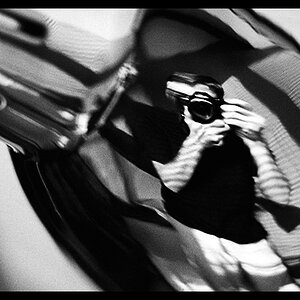A functioning light meter is essential to you as a complete novice. Curveball: buy the Yashica and buy an additional M42 lens mount adapter for it. In addition to your Yashica's native 'C/Y' lens mount, you can then also choose from the huge quantities of M42 lenses available on used markets everywhere. Yashica's own 'ML' lenses are good, and Contax's Zeiss lenses of the same mount are great.
Navigation
Install the app
How to install the app on iOS
Follow along with the video below to see how to install our site as a web app on your home screen.

Note: This feature currently requires accessing the site using the built-in Safari browser.
More options
You are using an out of date browser. It may not display this or other websites correctly.
You should upgrade or use an alternative browser.
You should upgrade or use an alternative browser.
Choice of 3 film cameras. Which one?
- Thread starter Mach2
- Start date
compur
Been spending a lot of time on here!
O, I even didn't know that. Thank's.None of the K1000 cameras ever used a mercury battery.
Maybe in 1976 mercury batteries were already phased out, or Pentax just never used them ?
Pentax did use mercury batteries in their "Spotmatic" cameras and some other models that preceded the K-series.
By the time the K-series models came out they had moved to other types of batteries.
timor
Been spending a lot of time on here!
- Joined
- Feb 28, 2011
- Messages
- 5,905
- Reaction score
- 890
- Location
- Toronto ON
- Can others edit my Photos
- Photos NOT OK to edit
O yes, right, Spotmatics. My F has LM still working, I have to check, what battery in it. Mercury ? Thank's compur. I never really cared about thos batteries as I always use mechanical cameras with hand held.O, I even didn't know that. Thank's.None of the K1000 cameras ever used a mercury battery.
Maybe in 1976 mercury batteries were already phased out, or Pentax just never used them ?
Pentax did use mercury batteries in their "Spotmatic" cameras and some other models that preceded the K-series.
By the time the K-series models came out they had moved to other types of batteries.
But then some say, that Spotmatics are voltage independent, will work the same way on mercury, wain or silver - oxide cell. True ?
compur
Been spending a lot of time on here!
But then some say, that Spotmatics are voltage independent, will work the same way on mercury, wain or silver - oxide cell. True ?
Well, it is true that many people believe it is true.
However, in my opinion it is a myth.
Some say the metering circuit of the Spotmatic has a voltage regulator that compensates for battery voltage variance. I have seen the circuit (it's in the Spotmatic service manual) and it contains no voltage regulator.
If you think about it, why would the Pentax engineers include such a thing in their camera? Because they predicted that mercury batteries would be outlawed decades in the future and replaced by batteries of different voltage? Not likely.
The good news is that most any camera that was designed to run on mercury cells can either be modified internally so that the battery voltage is dropped to the old mercury battery level or a substitute battery or adapter can do the same thing. With the Spotmatic, since its battery is so small, the only option I know of is to modify the camera by placing a little thing called a diode (of a certain type) inside the camera which drops the voltage of the substitute battery to the correct level. This is easy to do by anyone familiar with electronics soldering who has the tools to do so.
Or, one could simply compare the meter readings of the camera with one known to be accurate and compensate accordingly by adjustment of the ASA/ISO dial.
The Spotmatic F, however, uses the larger PX13/PX625 battery and there is a nifty solution for that called the MR-9 battery adapter which accepts an S76/LR44 type cell and drops its voltage to the correct level. It's a neat and easy fix that works with lots of cameras that use that battery.
Last edited:
- Joined
- Jun 9, 2013
- Messages
- 20,580
- Reaction score
- 12,709
- Website
- moderndinosaur.wordpress.com
- Can others edit my Photos
- Photos NOT OK to edit
Good thing the battery in my Spotmatic is well and truly stuck in the camera by corrosion so I don't have to worry about the modification :lmao:
vintagesnaps
Been spending a lot of time on here!
- Joined
- Jan 13, 2013
- Messages
- 9,119
- Reaction score
- 3,109
- Location
- US
- Can others edit my Photos
- Photos NOT OK to edit
A Pentax might give you more lens options. I like using mechanical film cameras and there are a number from that era that would probably be equally good. I'm not familiar with the Yashica and the Praktica could be good but might be harder to find lenses for.
I think there was a good suggestion earlier that it might be worth finding one that's in working condition. Preferably not just that the shutter releases etc. but that the seller had run film thru it.
Starting out it might be good to have a working meter. I agree that experienced photographers can often determine settings based on experience but using the meter would enable you to get the shutter speed and aperture set to get proper exposures. A hand held meter could be an option too but I don't know if that would be as convenient when starting out.
I think there was a good suggestion earlier that it might be worth finding one that's in working condition. Preferably not just that the shutter releases etc. but that the seller had run film thru it.
Starting out it might be good to have a working meter. I agree that experienced photographers can often determine settings based on experience but using the meter would enable you to get the shutter speed and aperture set to get proper exposures. A hand held meter could be an option too but I don't know if that would be as convenient when starting out.
timor
Been spending a lot of time on here!
- Joined
- Feb 28, 2011
- Messages
- 5,905
- Reaction score
- 890
- Location
- Toronto ON
- Can others edit my Photos
- Photos NOT OK to edit
Thanks compur. Yes, my F has PX625 of German make (Varta). Still good, I don't know, how old, don't care, use Sekonic with all my stuff anyway. No headache.However, in my opinion it is a myth.
gsgary
Been spending a lot of time on here!
- Joined
- Oct 31, 2008
- Messages
- 16,143
- Reaction score
- 3,002
- Location
- Chesterfield UK
- Website
- www.gsgary.smugmug.com
- Can others edit my Photos
- Photos OK to edit
The small battery company have the aircell the replace the px625
cgw
Been spending a lot of time on here!
But then some say, that Spotmatics are voltage independent, will work the same way on mercury, wain or silver - oxide cell. True ?
Well, it is true that many people believe it is true.
However, in my opinion it is a myth.
Some say the metering circuit of the Spotmatic has a voltage regulator that compensates for battery voltage variance. I have seen the circuit (it's in the Spotmatic service manual) and it contains no voltage regulator.
If you think about it, why would the Pentax engineers include such a thing in their camera? Because they predicted that mercury batteries would be outlawed decades in the future and replaced by batteries of different voltage? Not likely.
The good news is that most any camera that was designed to run on mercury cells can either be modified internally so that the battery voltage is dropped to the old mercury battery level or a substitute battery or adapter can do the same thing. With the Spotmatic, since its battery is so small, the only option I know of is to modify the camera by placing a little thing called a diode (of a certain type) inside the camera which drops the voltage of the substitute battery to the correct level. This is easy to do by anyone familiar with electronics soldering who has the tools to do so.
Or, one could simply compare the meter readings of the camera with one known to be accurate and compensate accordingly by adjustment of the ASA/ISO dial.
The Spotmatic F, however, uses the larger PX13/PX625 battery and there is a nifty solution for that called the MR-9 battery adapter which accepts an S76/LR44 type cell and drops its voltage to the correct level. It's a neat and easy fix that works with lots of cameras that use that battery.
Easier said than done since it's wholly dependent on access to the metering circuitry and knowing which diode to transplant. Why not post a link showing how the surgery goes?
The problem with MR-9s is that they cost more than many of these thrift store classics. Worth it? Doubtful, given the alternatives
cgw
Been spending a lot of time on here!
The small battery company have the aircell the replace the px625
Zinc-air cells like the Wein cell (and various hearing aid batteries hacked to fit) are all the same and tend to be very short-lived compared to the old merc cells. Hearing aid batteries are far cheaper and readily available.
Anyone interested in solutions only needs to Google "PX625 replacements."
gsgary
Been spending a lot of time on here!
- Joined
- Oct 31, 2008
- Messages
- 16,143
- Reaction score
- 3,002
- Location
- Chesterfield UK
- Website
- www.gsgary.smugmug.com
- Can others edit my Photos
- Photos OK to edit
Easier said than done since it's wholly dependent on access to the metering circuitry and knowing which diode to transplant. Why not post a link showing how the surgery goes?
The problem with MR-9s is that they cost more than many of these thrift store classics. Worth it? Doubtful, given the alternatives
I've got an mr9 they cost but over the year it is cheaper
cgw
Been spending a lot of time on here!
Easier said than done since it's wholly dependent on access to the metering circuitry and knowing which diode to transplant. Why not post a link showing how the surgery goes?
The problem with MR-9s is that they cost more than many of these thrift store classics. Worth it? Doubtful, given the alternatives
I've got an mr9 they cost but over the year it is cheaper
They're US$37. I bought a clean Nikon N90s body last year for forty bucks. Just too many newer, more capable film cameras available to bother. YMMV, as always.
compur
Been spending a lot of time on here!
Easier said than done since it's wholly dependent on access to the metering circuitry and knowing which diode to transplant. Why not post a link showing how the surgery goes?
Most everything is "easier said then done." But, if "easy" is your goal, buy a digital point & shoot camera.

I said it is easily done by someone familiar with electronics soldering and who has the tools to do so. I should add that it also requires a bit of disassembly of the camera to access the wiring. However, the meter circuits on these old cameras are simple and the diode can be placed most anywhere in the circuit so the easiest way is usually to place it next to the battery compartment, an area that most often requires only minor surgery to access. In most cases all you need to do is remove the top or bottom cover of the camera. I would think anyone who has done electronics work would not find this too challenging a task though a few tools are required.
Here is a video that shows the process on a Canon FTb:
The above example, an FTb, is probably one of the most time consuming since it requires removal of the top cover. Still, it's not all that difficult if you take it one step at a time and have reasonably good tools. On many cameras the battery compartment is on the bottom which makes things much easier -- removing the bottom cover only requires removal of a few screws and off it comes.
There are lots of other How-To articles and videos on the web that show this sort of operation.
... and knowing which diode to transplant.
Here is an example of a diode that will work:
Germanium Diode for Voltage Dropping Applications
Electronics components usually have equivalent components so there are other diodes that will work as well. Search the web for these if necessary. If you live near a reasonably large metro area you can probably purchase such a diode locally for less than a dollar.
Now, let me say again that all of this is for those who have done some electronics work and have the proper tools and inclination to do this sort of thing. For the rest, the MR-9 battery adapter is a far simpler solution for any camera or meter that uses the PX13/PX625 battery.
The problem with MR-9s is that they cost more than many of these thrift store classics. Worth it? Doubtful, given the alternatives
I see three MR-9 adapters on eBay USA right now ranging in price from $9-$14 shipped. Since you only have to buy it once and can use it on any number of cameras, it seems like a pretty reasonably priced solution to me and does not require any of the above tinkering.
Last edited by a moderator:
gsgary
Been spending a lot of time on here!
- Joined
- Oct 31, 2008
- Messages
- 16,143
- Reaction score
- 3,002
- Location
- Chesterfield UK
- Website
- www.gsgary.smugmug.com
- Can others edit my Photos
- Photos OK to edit
Easier said than done since it's wholly dependent on access to the metering circuitry and knowing which diode to transplant. Why not post a link showing how the surgery goes?
The problem with MR-9s is that they cost more than many of these thrift store classics. Worth it? Doubtful, given the alternatives
I've got an mr9 they cost but over the year it is cheaper
They're US$37. I bought a clean Nikon N90s body last year for forty bucks. Just too many newer, more capable film cameras available to bother. YMMV, as always.
So far all my film cameras are battery free but i could be getting a Rollei XF35 which will use the adapter
cgw
Been spending a lot of time on here!
I see three MR-9 adapters on eBay USA right now ranging in price from $9-$14 shipped. Since you only have to buy it once and can use it on any number of cameras, it seems like a pretty reasonably priced solution to me and does not require any of the above tinkering.
I'm thinking there's a bit of chance that the HK knock-offs don't really deliver. If you want the CRIS originals that work--I have a couple and they do--you're not going to get 'em at those prices. Most simply allow a smaller zinc-air hearing aid battery(notice the holes in the cheapo adapter?) to fit in a PX625 battery chamber. For 6 bucks, those are probably worth it. The others? Caveat emptor.
Battery woes aside, 60s-70s SLRs aren't exactly free of age-related issues. With camera repair usually exceeding their cost(assuming you can find it), old manual bodies can be a crap shoot now. Not sure anyone just starting film photography wants the headaches.
I'm thinking there's a bit of chance that the HK knock-offs don't really deliver. If you want the CRIS originals that work--I have a couple and they do--you're not going to get 'em at those prices. Most simply allow a smaller zinc-air hearing aid battery(notice the holes in the cheapo adapter?) to fit in a PX625 battery chamber. For 6 bucks, those are probably worth it. The others? Caveat emptor.
Battery woes aside, 60s-70s SLRs aren't exactly free of age-related issues. With camera repair usually exceeding their cost(assuming you can find it), old manual bodies can be a crap shoot now. Not sure anyone just starting film photography wants the headaches.
Similar threads
- Replies
- 10
- Views
- 708
- Replies
- 5
- Views
- 162


![[No title]](/data/xfmg/thumbnail/42/42057-1509913128bb1db2bc11235c05832fd4.jpg?1619739993)









